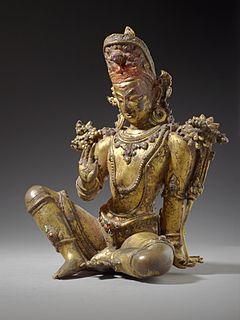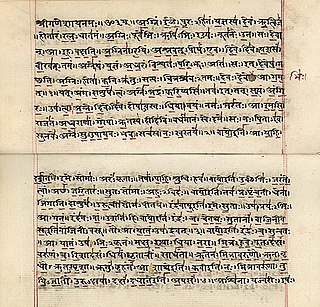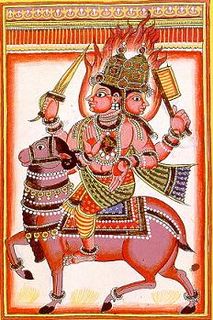Hindu deities are the gods and goddesses in Hinduism. The terms and epithets for deity within the diverse traditions of Hinduism vary, and include Deva, Devi, Ishvara, Ishvari, Bhagavān and Bhagavati.

Prajapati is a Vedic deity of Hinduism. In later literature, Prajapati is identified with the creator god Brahma, but the term also connotes many different gods, depending on the Hindu text, ranging from being the creator god to being same as one of the following: Viswakarma, Agni, Indra, Daksha and many others, reflecting the diverse Hindu cosmology. In classical and medieval era literature, Prajapati is equated to the metaphysical concept called Brahman as Prajapati-Brahman, or alternatively Brahman is described as one who existed before Prajapati.

The Brahmanas are Vedic śruti works attached to the Samhitas of the Rig, Sama, Yajur, and Atharva Vedas. They are a secondary layer or classification of Sanskrit texts embedded within each Veda, often explain and instruct Brahmins on the performance of Vedic rituals. In addition to explaining the symbolism and meaning of the Samhitas, Brahmana literature also expounds scientific knowledge of the Vedic Period, including observational astronomy and, particularly in relation to altar construction, geometry. Divergent in nature, some Brahmanas also contain mystical and philosophical material that constitutes Aranyakas and Upanishads.
Samhita literally means "put together, joined, union", a "collection", and "a methodically, rule-based combination of text or verses". Samhita also refers to the most ancient layer of text in the Vedas, consisting of mantras, hymns, prayers, litanies and benedictions.

Yajna refers in Hinduism to any ritual done in front of a sacred fire, often with mantras. Yajna has been a Vedic tradition, described in a layer of Vedic literature called Brahmanas, as well as Yajurveda. The tradition has evolved from offering oblations and libations into sacred fire to symbolic offerings in the presence of sacred fire (Agni).
Dāsa is a Sanskrit word found in ancient Indian texts such as the Rigveda and Arthasastra. It usually means "enemy" or "servant" but dasa, or das, also means a "servant of God", "devotee," "votary" or "one who has surrendered to God". Dasa may be a suffix of a given name to indicate a "servant" of a revered person or a particular deity.
Hindu texts are manuscripts and voluminous historical literature related to any of the diverse traditions within Hinduism. A few texts are shared resources across these traditions and broadly considered as Hindu scriptures. These include the Puranas, Itihasa and Vedas. Scholars hesitate in defining the term "Hindu scriptures" given the diverse nature of Hinduism, but many list the Bhagavad Gita and the Agamas as Hindu scriptures, and Dominic Goodall includes Bhagavata Purana and Yajnavalkya Smriti in the list of Hindu scriptures as well.

Ushas is a Vedic goddess of dawn in Hinduism. She repeatedly appears in the Rigvedic hymns, states David Kinsley, where she is "consistently identified with dawn, revealing herself with the daily coming of light to the world, driving away oppressive darkness, chasing away evil demons, rousing all life, setting all things in motion, sending everyone off to do their duties". She is the life of all living creatures, the impeller of action and breath, the foe of chaos and confusion, the auspicious arouser of cosmic and moral order called the Ṛta in Hinduism.

Deva means "heavenly, divine, anything of excellence", and is also one of the terms for a deity in Hinduism. Deva is a masculine term; the feminine equivalent is Devi.

The Vedas are a large body of religious texts originating in ancient India. Composed in Vedic Sanskrit, the texts constitute the oldest layer of Sanskrit literature and the oldest scriptures of Hinduism.
The Vedanga are six auxiliary disciplines of Hinduism that developed in ancient times and have been connected with the study of the Vedas:
- Shiksha : phonetics, phonology, pronunciation. This auxiliary discipline has focused on the letters of the Sanskrit alphabet, accent, quantity, stress, melody and rules of euphonic combination of words during a Vedic recitation.
- Chandas : prosody. This auxiliary discipline has focused on the poetic meters, including those based on fixed number of syllables per verse, and those based on fixed number of morae per verse.
- Vyakarana : grammar and linguistic analysis. This auxiliary discipline has focused on the rules of grammar and linguistic analysis to establish the exact form of words and sentences to properly express ideas.
- Nirukta : etymology, explanation of words, particularly those that are archaic and have ancient uses with unclear meaning. This auxiliary discipline has focused on linguistic analysis to help establish the proper meaning of the words, given the context they are used in.
- Kalpa : ritual instructions. This field focused on standardizing procedures for Vedic rituals, rites of passage rituals associated with major life events such as birth, wedding and death in family, as well as discussing the personal conduct and proper duties of an individual in different stages of his life.
- Jyotisha : Auspicious time for rituals, astrology and astronomy. This auxiliary Vedic discipline focused on time keeping.

Śrauta is a Sanskrit word that means "belonging to śruti", that is, anything based on the Vedas of Hinduism. It is an adjective and prefix for texts, ceremonies or person associated with śruti. The term, for example, refers to Brahmins who specialise in the śruti corpus of texts, and Śrauta Brahmin traditions in modern times can be seen in Kerala and Coastal Andhra.

Sanskara are rites of passage in a human being's life described in ancient Sanskrit texts, as well as a concept in the karma theory of Indian philosophies. The word literally means "putting together, making perfect, getting ready, to prepare", or "a sacred or sanctifying ceremony" in ancient Sanskrit and Pali texts of India.

In the Vedic Hinduism, a homa also known as havan, is a fire ritual performed on special occasions by a Hindu priest usually for a homeowner. The grihasth keeps different kinds of fire including one to cook food, heat his home, amongst other uses; therefore, a Yagya offering is made directly into the fire. A homa is sometimes called a "sacrifice ritual" because the fire destroys the offering, but a homa is more accurately a "votive ritual". The fire is the agent, and the offerings include those that are material and symbolic such as grains, ghee, milk, incense and seeds.
Kalpa means "proper, fit" and is one of the six disciplines of the Vedānga, or ancillary science connected with the Vedas – the scriptures of Hinduism. This field of study is focused on the procedures and ceremonies associated with Vedic ritual practice.

Pumsavana is the second of the 16 saṃskāras in ancient texts of Hinduism. The rite of passage is celebrated in the third or fourth month of pregnancy, typically after the pregnancy begins to show but before the baby begins to move in the womb.
Garbhadhana is the first of the 16 saṃskāras in Hinduism.
Jatakarman is one of the major samskaras in Hinduism, that celebrates the birth of a child. It is typically a private rite of passage that is observed by the new parents, relatives of the baby and close friends.

The Rigveda or Rig Veda is an ancient Indian collection of Vedic Sanskrit hymns. It is one of the four sacred canonical texts (śruti) of Hinduism known as the Vedas.

Agni is a Sanskrit word meaning fire and connotes the fire god of Hinduism. He is also the guardian deity of the southeast direction and is typically found in southeast corners of Hindu temples. In the classical cosmology of the Indian religions, Agni as fire is one of the five inert impermanent elements (pañcabhūtá) along with space (ākāśa), water (ap), air (vāyu) and earth (pṛthvī), the five combining to form the empirically perceived material existence (Prakriti).












